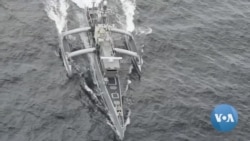ຂະນະທີ່ກອງທັບສະຫະລັດກຳລັງພິຈາລະນາເບິ່ງຄວາມເຂັ້ມແຂງທາງທະຫານຂອງຈີນຢູ່ພາກພື້ນອິນໂດປາຊີຟິກຢູ່ນີ້, ກອງທັບເຮືອກໍໄດ້ຫັນໄປຫາກຳປັ່ນບໍ່ມີຄົນຂັບຫຼື "ເຮືອໂດຣນ” ເພື່ອເພີ້ມກຳລັງແຮງຂອງຕົນຂຶ້ນ. Jessica Stone ນັກຂ່າວວີໂອເອ ຈະພາພວກເຮົາໄປເບິ່ງໃກ້ໆວ່ານະວັດຕະກຳໃໝ່ທາງການທະຫານອັນນີ້ ເປັນແນວໃດ ຊຶ່ງບົວສະຫວັນ ຈະນຳມາສະເໜີທ່ານໃນອັນດັບຕໍ່ໄປ.
ກຳປັ່ນບໍ່ມີຄົນຂັບ 4 ລຳນີ້ ແມ່ນສິ່ງນຶ່ງທີ່ເພີ້ມໃສ່ໃໝ່ຄັ້ງຫລ້າສຸດຂອງກອງທັບເຮືອສະຫະລັດ. ພວກເຮົາໄປພົບກັບກຳປັ່ນ Sea Hunter, Seahawk, Nomad ແລະ Ranger ເບິ່ງເນາະ.
ໃນລະດູຮ້ອນປີນີ້, ກອງທັບເຮືອໄດ້ໃຫ້ວີໂອເອເຂົ້າໄປເຖິງເປັນພິເສດ ເພື່ອຖ່າຍ ຮູບເອົາກຳປັ່ນເຫລົ່ານັ້ນເປັນຄັ້ງທຳອິດ.
ຜູ້ບັນຊາການເຈເຣເມຍ ເດລີ (Jeremiah Daley) ຈາກກອງທັບເຮືອສະຫະ ລັດໃຫ້ການສໍາພາດວ່າ:
“ພວກມັນພຽງແຕ່ໃຫ້ມີມະນຸດຂັບເຂົ້າໄປ ແລະອອກຈາກທ່າເຮືອ ເທົ່ານັ້ນ ເພື່ອຄວາມປອດໄພ.”
ຜູ້ບັນຊາການກອງທັບເຮືອສະຫະລັດ, ທ່ານເຈເຣເມຍ ເດລີ (Jeremiah Daley) ທີ່ອະນຸຍາດໃຫ້ວີໂອເອສຳພາດ ໂດຍການອັດໄດ້ແຕ່ສຽງເທົ່ານັ້ນ ໄດ້ນຳພາໜ່ວຍກຳປັ່ນຊຸດທຳອິດ ທີ່ປະກອບດ້ວຍກຳປັ່ນທີ່ປະຕິບັດການ ໂດຍມີການຄວບຄຸມຢູ່ຫ່າງ ຫຼື "ເຮືອໂດຣນ". ທ່ານເດລີກ່າວວ່າ ພາຫະນະບໍ່ມີຄົນຂັບເຫຼົ່ານີ້ - ທີ່ປັດຈຸບັນກຳລັງຖືກທົດລອງຢູ່- ໃນມື້ນຶ່ງ ອາດຈະເຮັດໃຫ້ກອງທັບເຮືອສາມາດລາດຕະເວນໄດ້ດີຂຶ້ນ ຢູ່ໃນເນື້ອທີ່ 165 ລ້ານ ກິໂລຕາແມັດ ທີ່ກວ້າງໃຫຍ່ຂອງມະຫາສະໝຸດປາຊີຟິກ.
ຍີ່ປຸ່ນ, ສິງກະໂປ, ເກົາຫຼີໃຕ້ ແລະຈີນ ລ້ວນແຕ່ມີໂຄງການພັດທະນາກຳປັ່ນ ທີ່ບໍ່ມີຄົນຂັບ. ທ່ານແຣນດີ ຊຣິຟເວີ (Randy Schriver) ອະດີດເຈົ້າໜ້າທີ່ຂັ້ນສູງຂອງທຳນຽບຫ້າແຈ ຮັບຜິດຊອບຂົງເຂດເອເຊຍ ກ່າວວ່າ ເຮືອໂດຣນເປັນສິ່ງສຳຄັນຫລາຍທີ່ສຸດ ທີ່ຈະຮັກສາເຂດອິນໂດປາຊີຟິກໃຫ້ເປັນເຂດອິດສະລະ ແລະ ເປີດກວ້າງໃນຂະນະທີ່ປະເຊີນກັບການຂະຫຍາຍອອກ ແລະມີຄວາມຮຸນແຮງນັບມື້ຂອງກອງທັບຈີນ.
ທ່ານຊຣິຟເວີ (Schriver) ອະດີດເຈົ້າໜ້າທີ່ດ້ານຍຸດທະສາດໃນຂົງເຂດເອເຊຍຂອງທຳນຽບຫ້າແຈ ກ່າວຜ່ານທາງ Zoom ວ່າ:
“ເນື້ອທີ່ທີ່ມີການຂັດແຍ້ງແຂ່ງຂັນກັນ ແມ່ນແນ່ນອນວ່າ ກຳລັງຂະຫຍາຍອອກ. ແລະຂ້າພະເຈົ້າຄິດວ່າ ຍານພາຫະນະທີ່ຂັບແບບອັດຕະໂນມັດ ຫຼືບໍ່ມີຄົນຂັບ ບໍ່ວ່າຈະເປັນກຳປັ່ນດຳນ້ຳ ຫລື ຢູ່ເທິງໜ້ານ້ຳ ແມ່ນມີລາຄາຖືກກວ່າ. ພວກມັນເປັນສິ່ງທີ່ເຮັດໃຫ້ເຮົາສາມາດຈ່າຍໄດ້ຫຼາຍກວ່າ ໃນແງ່ຂອງການບໍ່ມີຄວາມສ່ຽງຕໍ່ຊີວິດຂອງລູກເຮືອ."
ທ່ານເຈມສ໌ ຊາຍເບນສ໌ (James Siebens), ນັກຄົ້ນຄວ້າດ້ານຍຸດທະສາດ ໃນການປ້ອງກັນຊາດຂອງສູນສຕິມສັນ (Stimson) ເປັນຫ່ວງວ່າ ພາຫະນະ ເຮືອເຫຼົ່ານີ້ ອາດເຮັດໃຫ້ເປັນເປົ້າຫມາຍທາງທະຫານທີ່ໜ້າດຶງດູດຄວາມສົນໃຈຫລາຍຂຶ້ນ.
ທ່ານຊາຍເບນສ໌ຈາກສູນ Stimson ກ່າວຜ່ານທາງ Zoom ວ່າ:
"ໃນດ້ານນຶ່ງ, ຈີນອາດຈະຖືວ່າເຮືອທີ່ບໍ່ມີຄົນຂັບ ເປັນເປົ້າຫມາຍທີ່ມີຄວາມຂະຫຍາຍຕົວເພີ່ມຂຶ້ນຫນ້ອຍກວ່າ ເພື່ອຈະທົດລອງລູກສອນໄຟຕ້ານກຳປັ່ນ."
ທ່ານຊາຍເບນສ໌ກ່າວອີກວ່າ ເຖິງແມ່ນວ່າ ຈະມີຄວາມເປັນຫ່ວງດັ່ງກ່າວກໍ່ຕາມ, ແຕ່ກຳປັ່ນທີ່ບໍ່ມີຄົນຂັບ ສາມາດມີຄວາມສຳຄັນໃນການຕອບໂຕ້ກັບການປິດລ້ອມຂອງຈີນຕໍ່ໄຕ້ຫວັນໄດ້.
ຜູ້ບັນຊາການເດລີມ້ວນທ້າຍກ່າວວ່າ ພາຫະນະບໍ່ມີຄົນຂັບຄວນໄດ້ຮັບການເອົາໄປເຊື່ອມໂຍງເຂົ້າກັນກັບກອງທັບສະຫະລັດຢ່າງເຕັມສ່ວນ ໃນບໍ່ເທົ່າໃດປີຂ້າງໜ້ານີ້.
ອ່ານຂ່າວນີ້ເພີ້ມເປັນພາສາອັງກິດຢູ່ລຸ່ມນີ້:
As the U.S. military considers China’s military strength in the Indo-Pacific region, the U.S. Navy is turning to driverless ships to multiply its forces. VOA’s Jessica Stone takes us along for a closer look at this military innovation
These four unmanned ships are among the newest additions to the U.S. Navy. Meet Sea Hunter, Seahawk, Nomad and Ranger.
This summer, the Navy gave VOA special access to photograph them for the first time.
Cmdr. Jeremiah Daley, U.S. Navy (audio only interview) "they are only meant to be driven in and out of port by humans for safety.”
U.S. Naval Commander Jeremiah Daley, permitted to give VOA an audio-only interview, leads the first division made up of remotely operated ships — or "drone boats." Daley says these unmanned vessels — currently being piloted — could one day enable the Navy to better patrol the vast 165 million square kilometers of the Pacific Ocean.
Japan, Singapore, South Korea and China all have programs to develop driverless ships. Former top Pentagon Asia official Randy Schriver says drone boats are critical to maintain a free and open Indo-Pacific in the face of an expanding and assertive Chinese military.
Randy Schriver, Former Pentagon Asia Strategy Official via Zoom:
“The spaces that are contested are certainly growing. And I think autonomous or unmanned vehicles either submerged or on the surface are cheaper. They're more expendable in terms of not risking the lives of sailors.”
James Siebens, a defense strategy fellow at the Stimson Center, worries that these vessels could make a more attractive military target.
James Siebens, Stimson Center via Zoom: “China, for one, might regard an unmanned vessel as a less escalatory target to test out an anti-ship missile.”
Siebens says that despite those concerns, driverless ships could be critical in responding to a Chinese blockade of Taiwan.
Commander Daley says the unmanned surface vehicles should be fully integrated into the U.S. military in the next few years.










